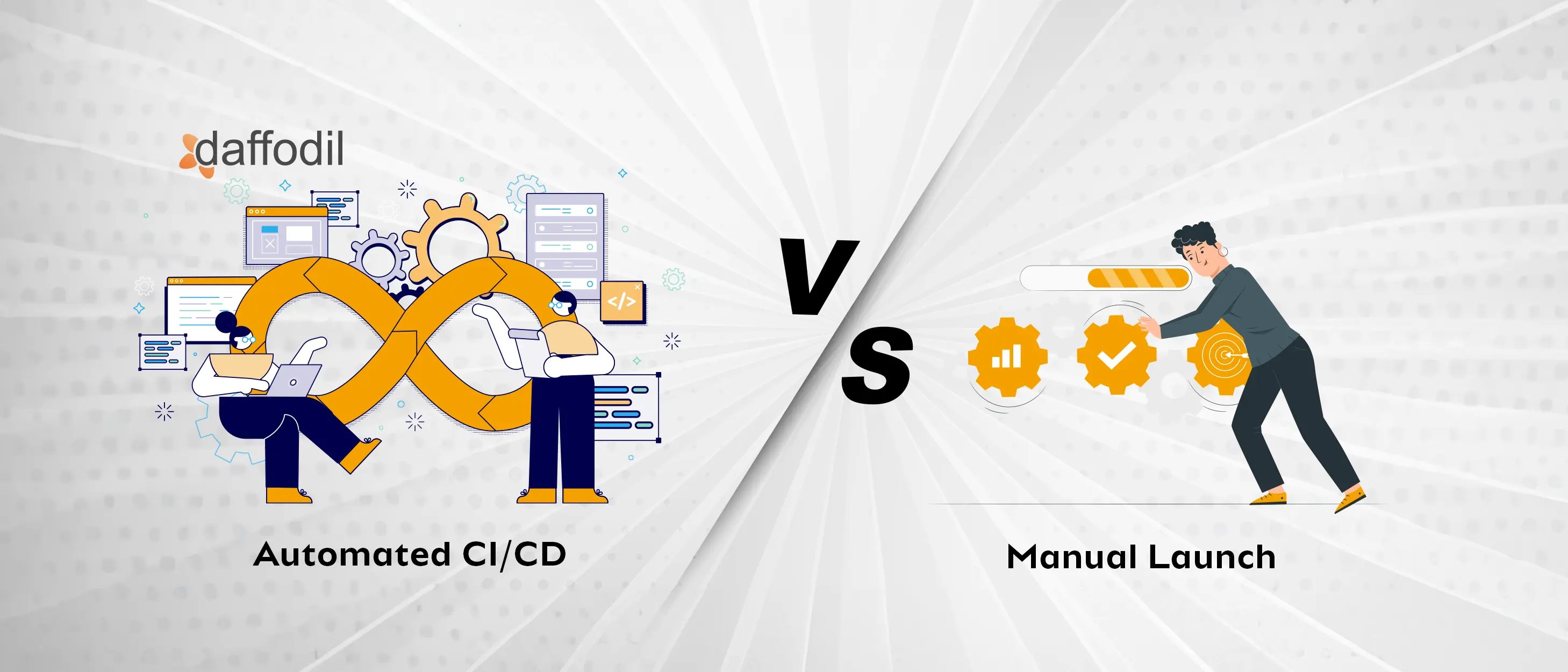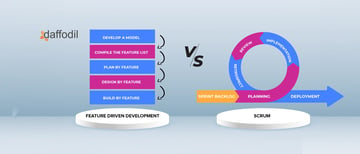
The deployment strategy adopted by a software team is critical to the product's performance and market success. Automated Continuous Integration/ Continuous Delivery/ Deployment (CI/CD) solutions improve deployment efficiency, reduce errors, and enable agile development, allowing teams to focus on innovation. On the other hand, manual launches allow for more precise control, making them suitable for specialized or cautious rollouts.
Let’s compare the automated CI/CD approach vs the manual deployment, covering how both approaches influence the deployment speeds, their use cases, and complexity.
Why are Deployment Strategies Critical for Software Product Success?
Effective deployment methods are critical to the success of any software product as they assure the smooth and constant delivery of updates, patches, and new features. Using either CI/CD pipelines or manual procedures, the deployment strategy enables systematic and gradual release processes, reducing service interruptions and ensuring a consistent user experience. They encourage quick development cycles and user-centric innovations, allowing for rapid response to consumer feedback. Deployment strategies are also useful in risk management since they allow you to reverse changes if problems develop, maintain product quality, and comply with security and regulatory requirements.
In essence, a strong deployment strategy is vital for ensuring user satisfaction, protecting software integrity, and maintaining a company's market relevance in the midst of rapid technological development.
When Should You Implement Automated CI/CD as Your Deployment Strategy?
Automated CI/CD is particularly helpful in cases when the software development life cycle is defined by frequent modifications and upgrades. This is frequently consistent with Agile and DevOps techniques, in which iterative development and ongoing feedback are essential. Some of the use cases where automated CI/CD deployment is preferable includes:
- High-frequency Deployments: Automated pipelines that can deliver changes rapidly and consistently are extremely beneficial for projects that require frequent updates, often multiple times a day or in a week.
- Large Teams: With many people contributing to the code, automated CI/CD aids in the management of multiple codebases, ensuring that merges and tests are handled systematically.
- Complexity of the application: Automated CI/CD can significantly reduce integration challenges and assist in maintaining stability in complex programs with numerous interdependent components.
- Regulatory Compliance: Automated CI/CD pipelines provide logs for each change and deployment, which is useful for projects that require strict adherence and auditing procedures.
ALSO READ: 10 KEY DEVOPS METRICS TO MANAGER DEPLOYMENT PIPELINE
When Should You Choose Manual Methods of Deployment Over Automated Deployment?
Even though automated CI/CD has many benefits, there are some situations in which manual launches could be preferable. The following situations are when manual methods can be useful:
- Complex Deployment Processes: Integrating CI/CD with legacy systems and monolithic apps is frequently difficult due to their inherent complexity. Manual deployment may be preferred, particularly when specific pre-deployment approval activities are necessary that cannot be effectively automated, necessitating a more hands-on approach to release management.
- Sensitive or Critical Deployments: Manual deployment is favored for high-risk changes involving critical databases or sensitive data to ensure careful oversight. Similarly, industries with strict compliance require manual processes to maintain compliance and ensure data integrity and security.
- Limited Resources: For small-scale projects or startups with limited resources, the initial investment in developing a CI/CD pipeline might not be justified.
- Stability Concerns: Manual deployment may be preferred for unstable builds that need stability verification or when automated testing is insufficient to verify quality before production.
- Cost Considerations: Manual techniques might be more cost-effective and simple for projects that require just periodic deployment.
- Training & Development: Manual deployments are educational, providing new developers with insight into the deployment process and facilitating the distribution of system expertise among team members for better risk management.
Why do CI/CD have an Upper Hand Over Manual Approach?
- Improved Accuracy: By introducing continuous automatic updates and continuous delivery pipelines, we can reduce human error and ensure that the final product brought to market meets the highest standards. This increases customer satisfaction while reducing the probability of product recalls or negative responses upon release.
- Faster Release Cycles: By CI/CD pipelines, the time frame from development to deployment is significantly shortened. This increased flexibility provides a competitive advantage by enabling prompt responses to customer demands and more expedited delivery of value.
- Accelerated Time: When developers use automation to handle repetitive tasks, they can concentrate on coming up with new ideas and improving the product.
- Consistency and Productivity: Automated pipelines ensure consistent procedures are followed each time, resulting in reliable builds and deployments. This makes it easy to identify and address issues, as well as revert changes if needed.
- Early Detection of Issues & Faster Issue Resolution: Continuous testing means bugs are caught early in the development process, which is generally less costly to fix than those discovered later in production.
- Better Collaboration: CI/CD pipelines often integrate changes from all developers, reduce potential conflicts, and help teams work better together.
Challenges of Implementing Automated CI/CD Pipelines
- Initial Setup Costs: Creating a CI/CD pipeline can necessitate a significant upfront investment of both time and resources. This comprises choosing and configuring the required tools, training the team, and developing the initial set of automated tests.
- The complexity of Pipeline Configuration: As the application expands, the CI/CD pipeline can become complex, requiring skilled employees to manage and maintain the pipeline, as well as debug any challenges that arise during the build, test, or deployment phases.
- Need for a Robust Testing Suite: To properly leverage CI/CD, a thorough suite of automated tests that can reliably analyze the application's functionality and performance at each update is required. Developing and maintaining such a suite requires a significant continuing effort.
What are the Challenges of the Manual Launch Process?
Manual procedures, although providing control and monitoring, have several drawbacks and restrictions. Here are some potential drawbacks associated with manual launches:
- Human Error & Safety Issues: One of the major disadvantages of manual operations is how susceptible they are to human mistakes. Miscommunication, data entry mistakes, or oversights during quality checks can all result in costly consequences such as product failures, customer dissatisfaction, and even safety risks.
- Slower Time: There is a big possibility of delay when every step involves a person and this slowing down could be a problem in organizations that have speed to market as a key factor in the competition.
- Scalability Problems: The scalability of the manual approach is very limited. With the company growing, the number of people needed to complete a manual process could increase at the same rate, bringing additional cost and complexity.
- Inefficiency and Increased Costs: Manual launches entail more effort, time, and resources, resulting in higher costs. Processes that can be automated to save both time and funds on labor are costly due to the manual efforts required.
- Lack of Consistency: Manual procedures may not be able to meet the required accuracy and consistency that automation ensures. Since the human factor is involved there may arise the issue of variations in the final product or the service which in turn may influence the brand or the customer satisfaction.
- Difficulty in Tracking and Monitoring: Manual processes can be the cause of the issue of taking into account progress and the quality of the launch during the phase of the launch. This may lead to the problems being neglected up to the time they become crises.
ALSO READ: 10 EVOLVING TRENDS IN SOFTWARE DEVELOPMENT
Embracing the Automated CI/CD Approach
In summary, a software team's deployment strategy, whether automated CI/CD or manual launch, has a major impact on product success. Automated CI/CD excels in speed, consistency, and rapid market reaction, making it perfect for software development. Manual techniques provide extensive oversight, which is ideal for complex or sensitive deployments. While each has advantages and disadvantages, the ultimate decision is based on project requirements, risk tolerance, and resource availability.
If you want to revolutionize your software deployment and streamline your development workflow, schedule a no-obligation consultation with our experts now!





